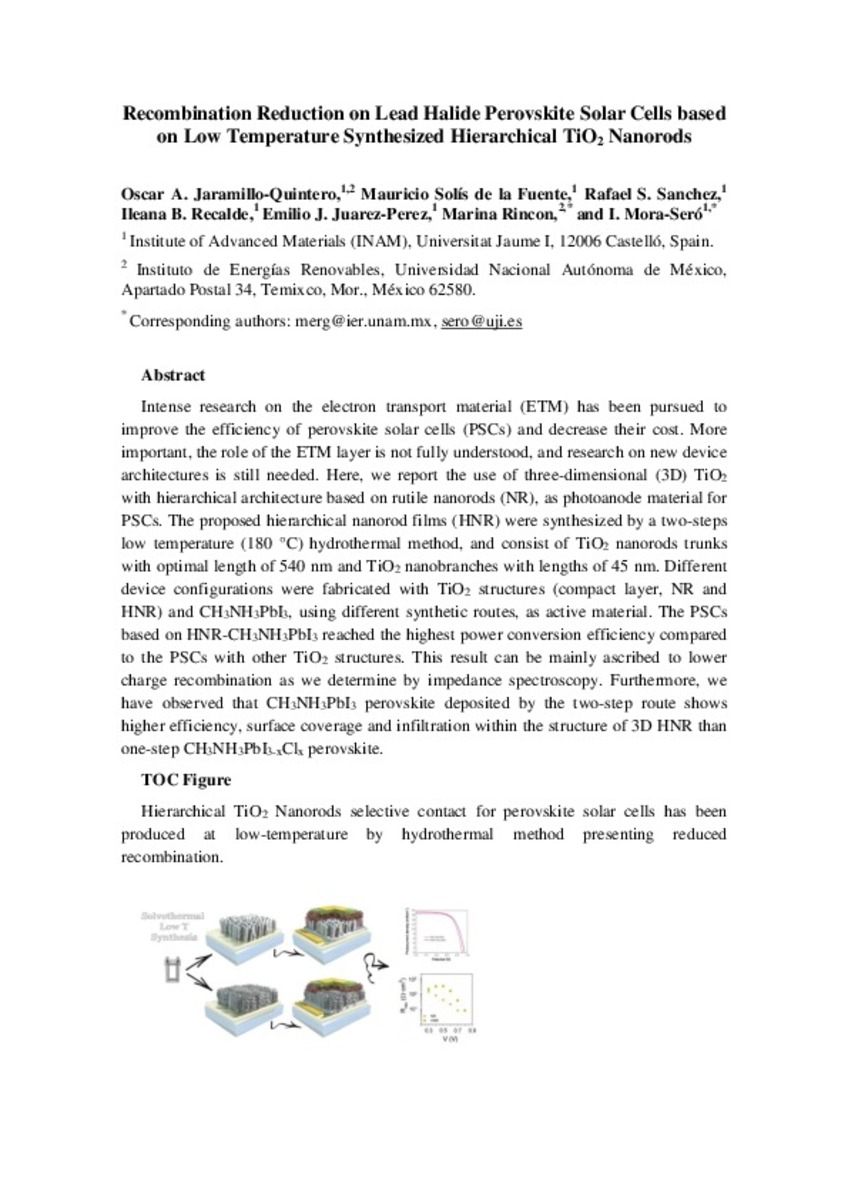Mostrar el registro sencillo del ítem
Recombination reduction on lead halide perovskite solar cells based on low temperature synthesized hierarchical TiO2 nanorods
| dc.contributor.author | Jaramillo Quintero, Óscar A. | |
| dc.contributor.author | Solís de la Fuente, Mauricio | |
| dc.contributor.author | S. Sánchez, Rafael | |
| dc.contributor.author | Recalde, Ileana B. | |
| dc.contributor.author | Juarez-Perez, Emilio J. | |
| dc.contributor.author | Rincón, Marina | |
| dc.contributor.author | Mora-Sero, Ivan | |
| dc.date.accessioned | 2016-06-15T15:26:48Z | |
| dc.date.available | 2016-06-15T15:26:48Z | |
| dc.date.issued | 2016 | |
| dc.identifier.issn | 2040-3364 | |
| dc.identifier.issn | 2040-3372 | |
| dc.identifier.uri | http://hdl.handle.net/10234/160746 | |
| dc.description.abstract | Intensive research on the electron transport material (ETM) has been pursued to improve the efficiency of perovskite solar cells (PSCs) and decrease their cost. More importantly, the role of the ETM layer is not yet fully understood, and research on new device architectures is still needed. Here, we report the use of three-dimensional (3D) TiO2 with a hierarchical architecture based on rutile nanorods (NR) as photoanode material for PSCs. The proposed hierarchical nanorod (HNR) films were synthesized by a two-step low temperature (180 °C) hydrothermal method, and consist of TiO2 nanorod trunks with optimal lengths of 540 nm and TiO2 nanobranches with lengths of 45 nm. Different device configurations were fabricated with TiO2 structures (compact layer, NR and HNR) and CH3NH3PbI3, using different synthetic routes, as the active material. PSCs based on HNR-CH3NH3PbI3 achieved the highest power conversion efficiency compared to PSCs with other TiO2 structures. This result can be ascribed mainly to lower charge recombination as determined by impedance spectroscopy. Furthermore, we have observed that the CH3NH3PbI3 perovskite deposited by the two-step route shows higher efficiency, surface coverage and infiltration within the structure of 3D HNR than the one-step CH3NH3PbI3−xClx perovskite. | ca_CA |
| dc.description.sponsorShip | This work was supported by the Universitat Jaume I (project 12I361.01/1), the Spanish MINECO (project MAT2013-47192- C3-1-R), CONACYT-México (project CB-2010/153270) and UNAM (PAPIIT-IN10301 | ca_CA |
| dc.format.extent | 7 p. | ca_CA |
| dc.format.mimetype | application/pdf | ca_CA |
| dc.language.iso | eng | ca_CA |
| dc.publisher | Royal Society of Chemistry | ca_CA |
| dc.relation.isPartOf | Nanoscale, 2016, vol. 8, núm. 12 | ca_CA |
| dc.rights | This journal is © The Royal Society of Chemistry 2016. Jaramillo-Quintero, O. A., de la Fuente, M. S., Sanchez, R. S., Recalde, I. B., Juarez-Perez, E. J., Rincón, M. E., & Mora-Seró, I. (2016). Recombination reduction on lead halide perovskite solar cells based on low temperature synthesized hierarchical TiO 2 nanorods. Nanoscale, 2016, vol. 8, núm. 12 <http://dx.doi.org/10.1039/C5NR06692A> -- Reproduced by permission of The Royal Society of Chemistry | ca_CA |
| dc.rights.uri | http://rightsstatements.org/vocab/InC/1.0/ | * |
| dc.subject | Efficiency | ca_CA |
| dc.subject | Electron transport properties | ca_CA |
| dc.subject | Perovskite | ca_CA |
| dc.subject | Solar cells | ca_CA |
| dc.title | Recombination reduction on lead halide perovskite solar cells based on low temperature synthesized hierarchical TiO2 nanorods | ca_CA |
| dc.type | info:eu-repo/semantics/article | ca_CA |
| dc.identifier.doi | http://dx.doi.org/10.1039/C5NR06692A | |
| dc.rights.accessRights | info:eu-repo/semantics/openAccess | ca_CA |
| dc.relation.publisherVersion | http://pubs.rsc.org/en/content/articlelanding/2016/nr/c5nr06692a#!divAbstract | ca_CA |
| dc.type.version | info:eu-repo/semantics/publishedVersion |
Ficheros en el ítem
Este ítem aparece en la(s) siguiente(s) colección(ones)
-
INAM_Articles [506]
-
FCA_Articles [501]
Articles de publicacions periódiques







